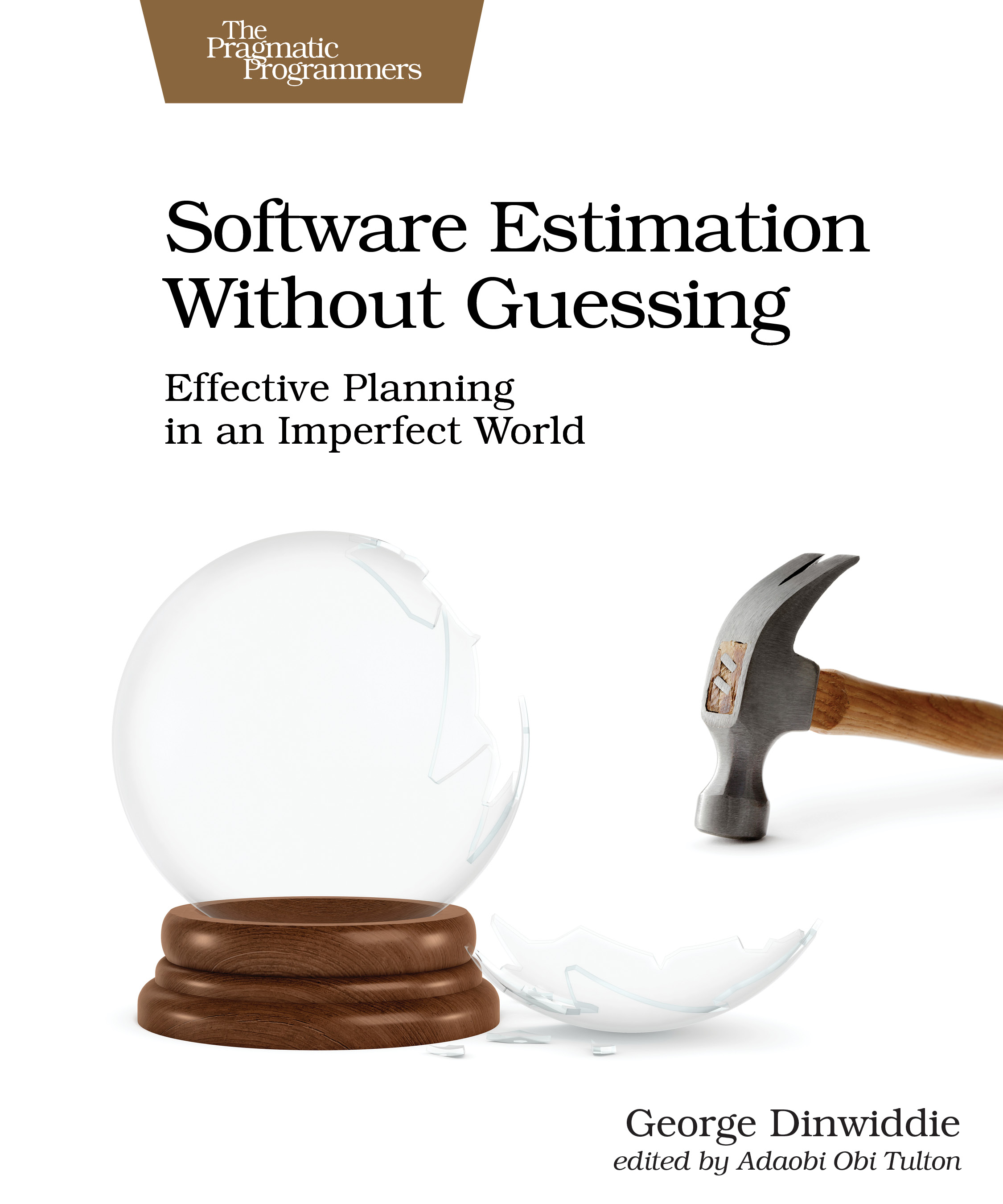Software Estimation Without Guessing
Effective Planning in an Imperfect World
by: George Dinwiddie
| Published | 2019-12-18 |
|---|---|
| Internal code | gdestimate |
| Print status | In Print |
| Pages | 246 |
| User level | Beginner |
| Keywords | Estimating, estimation, project management, software development, software development life cycle, productivity, management, human factors |
| Related titles | Predicting the Unpredictable, Johanna Rothman, 2015 |
| ISBN | 9781680506983 |
| Other ISBN |
Channel epub: 9781680507416 Channel PDF: 9781680507423 Kindle: 9781680507393 Safari: 9781680507409 Kindle: 9781680507393 |
| BISACs | COM051430 COMPUTERS / Software Development & Engineering / Project ManagementBUS101000 BUSINESS & ECONOMICS / Project ManagementBUS101000 BUSINESS & ECONOMICS / Project Management |
Highlight
Developers hate estimation, and most managers fear disappointment with the results, but there is hope for both. You’ll have to give up some widely held misconceptions: let go of the notion that “an estimate is an estimate,” and estimate for your particular need. Realize that estimates have a limited shelf-life, and re-estimate frequently as needed. When reality differs from your estimate, don’t lament; mine that disappointment for the gold that can be the longer-term jackpot. We’ll show you how.
Description
Estimating software development often produces more angst than value, but it doesn’t have to. Identify the needs behind estimate requests and determine how to meet those needs simply and easily. Choose estimation techniques based on current needs and available information, gaining benefit while reducing cost and effort. Detect bad assumptions that might sink your project if you don’t adjust your plans.
Learn strategies for effective decomposition of work and aspects of the work that likely affect your estimates. Hedge your bets by comparing the results of different approaches. Estimate in comparison to past experience, by modeling the work mathematically, or a hybrid of both. Discover what to do when an estimate proves wrong. And they will. They’re estimates, after all. Find out how to recover and how to use that knowledge for future planning. You’ll discover that you can use estimates to warn you of danger so you can take appropriate action in time. Learn to communicate about estimates in a healthy and productive way, maximizing advantage to the organization and minimizing damage to the people.
Address both the technical and sociological aspects of estimation, and you’ll help your organization achieve its desired goals with less drama and more benefit.
Contents and Extracts
- <b>Introduction</b>
- Benefit of Headlights
- Beyond Story Points and Planning Poker
- Definitions
- Who This Book Is For
- Goal of This Book
- What’s in This Book
- Conventions Used
- Now It’s Your Turn
- Starting Something New
- When You’re Asked to Estimate Something New
- Case: Developing a Fixed-Price Bid
- Case: Is This Worth Starting?
- Case: Can We Make This Work?
- Case: What Should We Budget?
- Case: Which of These Should We Choose?
- Case: A Mixture of Questions
- Stepping Back for a Broader View
- Now It’s Your Turn
- Comparison-Based Estimation
- Comparison to Past Experience
- Memory vs. Recorded Data
- <b>Aspects to Compare</b>
- Gestalt Estimation
- Decomposition
- Estimating the Unknown
- Stepping Back for a Broader View
- Now It’s Your Turn
- Decomposition for Estimation
- Which Way to Slice?
- Decomposing by Phase
- Decomposing by Implementation
- Decomposing by Functionality
- User Stories
- Decomposition Decisions
- A Large Number of Small Parts
- A Small Number of Large Parts
- Affinity Estimation
- Ordering the Parts
- Multi-Level Decomposition
- Comparing Big Items with Small Ones
- Decomposition Gotchas
- Stepping Back for a Broader View
- Now It’s Your Turn
- Checking Progress
- Getting Things Done
- Detecting Progress
- What to Measure
- Visualizing Progress
- Showing Value for the Money
- Efficiency and Effectiveness
- Optimization
- Are We Going Fast Enough? <b>excerpt</b>
- Pushing Our Limits
- Situational Awareness
- Stepping Back for a Broader View
- Now It’s Your Turn
- Model-Based Estimation
- Modeling the Size
- Modeling the Rate
- Unavoidable Subjectivity
- The Linear Model Approach
- Advanced Linear Model Techniques
- The Parametric Model Approach
- The Stochastic Model Approach
- Comparison-Model Hybrid
- Stepping Back for a Broader View
- Now It’s Your Turn
- Estimating Milestones
- Deadlines
- Early Release
- Coordination with Others
- <b>Evaluating and Changing Plans</b>
- Stepping Back for a Broader View
- Now It’s Your Turn
- When Estimates and Actuals Differ
- Driving Up Costs
- Salvaging the Situation
- Learning from the Situation
- Stepping Back for a Broader View
- Now It’s Your Turn
- Planning for Incorrect Predictions
- Seeking Out Information
- Setting Traps for Information
- Avoid Traps for the Unwary
- Stepping Back for a Broader View
- Now It’s Your Turn
- When People Clash
- It Starts So Innocently
- How It Goes Wrong
- Understanding Human Behavior
- Imagine a Better Situation
- Retraining Ourselves
- Tools for Better Understanding
- Stepping Back for a Broader View
- Now It’s Your Turn
- Conclusion
